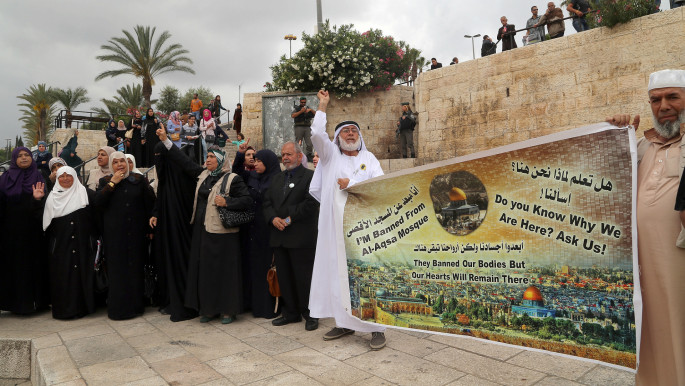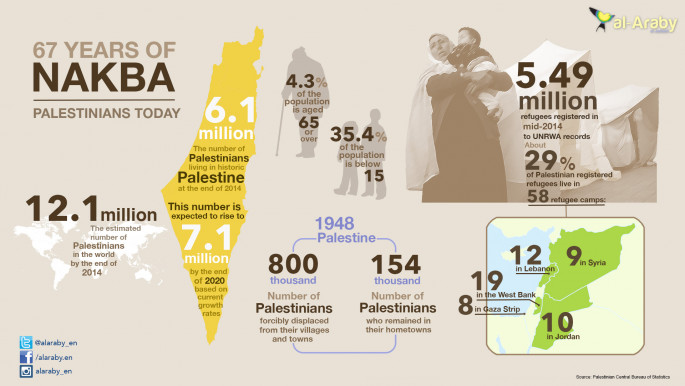Palestinians mark Nakba anniversary
Commemorations have commenced for the 67th Anniversary of Nakba, also known as 'The Catastrophe' where hundreds of thousands of Palestinians were driven from their land and Israel was created in 1948.
In 1998, the late President Yasser Arafat declared May 15 - the day after Israeli 'independence day' - as Nakba Day.
The day is now marked throughout Occupied Palestine, in camps in Arab states as well as with global demonstrations.
| UNRWA, the world body's aid agency for Palestinian refugees, has 5.49 million people registered on its books |
In 1948, 1.4 million Palestinians lived in 1,300 Palestinian towns and villages spreading over all of historic Palestine.
After the war that followed Israel's creation, Israel took control of 774 towns and villages, destroyed 531 and committed 70 killings and massacres in which 15,000 people died.
More than 800,000 Palestinians were forcibly displaced from their villages and towns into neighbouring countries including Jordan, Lebanon, Syria and Egypt.
Thousands of others remained in their hometowns in what became known as the ‘1948 areas’.
The displacement, dispossession and dispersal of Palestinian people is one of our age's most enduring and powerful symbols of injustice and of resistence.
From limitations to their basic rights, to discrimination and abuse, to crimes against humanity, the suffering of the Palestinian population continues to be a rallying cry for millions around the world.
 |
|
| Palestinians gather around al-Aqsa Mosque to commemorate Nakba Day (Anadolu) |
Thousands took to the streets in the West Bank cities of Ramallah, Nablus, Al-Khalil, Jenin and Bethlehem on Wednesday to mark the 67th anniversary.
Salem Matar, a 70-year-old Palestinian man who participated in the Ramallah march, told Anadolu Agency that he was only three years old when his family was driven out of the village of Dair Tarif, near what is today the Israeli city of Ramla.
"Seventy years has passed and I still dream of going back to the house of my father," he said.
Still holding the keys to his old home in Palestine, Matar said: "This is my legacy and my children’s legacy, which we will not forget."
He added: "We will go back to our land and will build a new house for this key."
Ruqayya Youssef Abu Laila left Acre in Palestine when she was 15 after the 1948 Deir Yassin massacre.
"We have suffered badly. I wish I could go back to Palestine," she told al-Araby al-Jadeed.
Jumaa Hassan Abu Hadrous, an 80-year-old refugee living in Gaza's Maghazi refugee camp said "God will allow justice to prevail, one day."
"Justice is in a deep sleep, but one day, justice will wake up and we will all definitely return back to our own homes," he added.
 |
|
| Palestinians today: Click here for larger image |
On Tuesday, the Palestinian Central Bureau of Statistics recorded a Palestinian population of 12.1 million people, of whom 4.6 million live in the occupied territories and the remainder abroad.
The statistics indicated that the number of Palestinians worldwide had multiplied by a 8.6-fold in the 67 years since the Nakba.
At the end of 2014, 2.8 million Palestinians lived in the West Bank and 1.8 million in the Gaza Strip.
In the impoverished Gaza enclave, the population of 4.9 people per square kilometre makes its density one of the world's highest.
Of the 4.6 million people in the Palestinian territories, 43.1 percent are refugees.
The balance of 7.5 million Palestinians live in exile, the majority in 31 UN-installed refugee camps in Jordan, Lebanon and Syria.
UNRWA, the world body's aid agency for Palestinian refugees, has 5.49 million people registered on its books.
Other figures made public by the Association for Civil Rights in Israel NGO show that Palestinians make up 37 percent of the population of Jerusalem.
Of the Palestinians in east Jerusalem, 75 percent live below the poverty line and the homes of almost 40 percent are threatened with destruction because they lack building permits from Israeli authorities.



